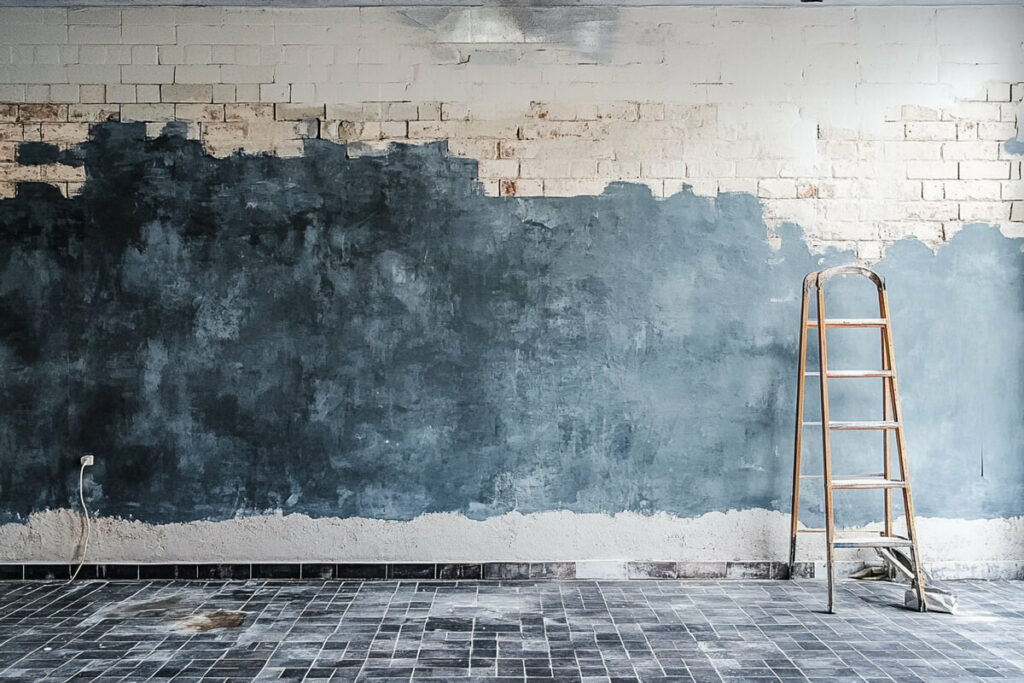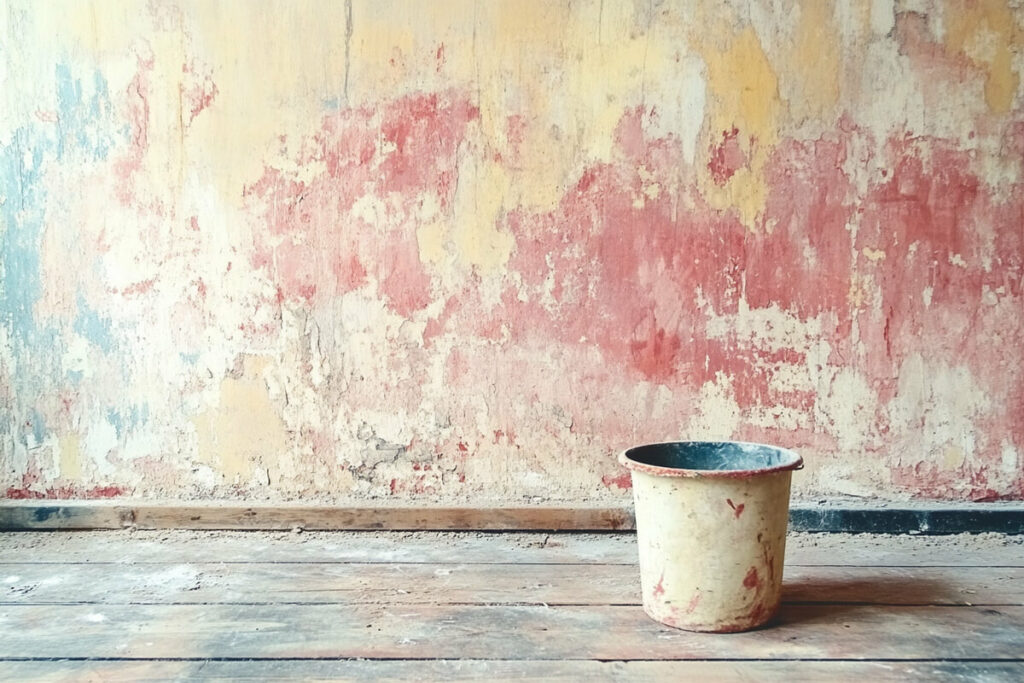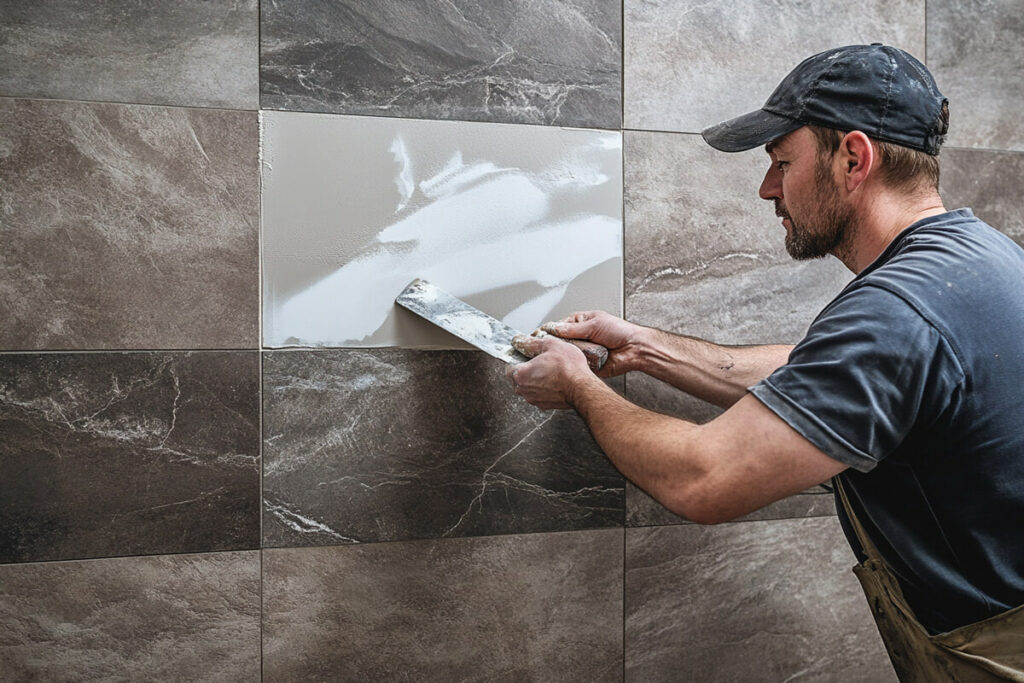Can you tile over a painted wall? The short answer is no. However, it doesn’t mean you can’t do anything about it. Tiling over a painted wall is generally discouraged because paint can weaken the bond between the tiles and the surface. According to British Standards (BS 5385), painted surfaces are usually unsuitable for tiling, especially if the paint has poor adhesion. However, with proper preparation, it’s possible to do this job.
Generally, you need to consider 3 important things: test the existing paint’s condition, thoroughly prep the wall, and choose the right materials. By following the right steps, you can avoid potential issues like loose tiles or failed adhesive bonds.
Here is what we will cover today:
- Challenges of tiling over painted walls
- How to prepare a painted wall for tiling
- Choosing the right adhesive for painted walls
- Tiling over gloss paint: is it possible?
- Alternatives to tiling directly on painted walls

Challenges of tiling over painted walls
The main issue with tiling over painted walls is that paint creates a barrier, that reduces the adhesive’s ability to bond properly with the surface. This is especially true for water-based paints like emulsion, which can soften when they come into contact with tile adhesive, leading to weak or failed bonds.
Another concern is the uneven surface that paint can create. Flaking, peeling, or poorly adhered paint makes it difficult to achieve a stable base for tiling. Larger tiles, typically over 30cm x 30cm, increase the risk of failure because they require a stronger adhesive bond than smaller tiles.
Finally, there’s the risk of damaging the wall itself. Removing paint, especially from plasterboard, can cause cracks or weaken the surface, further complicating the tiling process.
But the good news is that you can overcome these challenges if you try to remove the paint. We need to note, that this is often not the easiest process and is quite time-consuming, but it’s your only way if you want to tile your wall.

How to prepare a painted wall for tiling
There are three main steps you need to take:
Step #1 test the paint’s adhesion. Before starting, check if the paint adheres well to the wall. Use the duct tape test: press a strip of duct tape firmly onto the wall, then pull it off quickly. If the paint peels off, it needs to be removed completely.
Step #2 Remove loose or flaking paint. For water-based paints like emulsion, removal is essential. Use a wallpaper stripper to apply steam, softening the paint for easier scraping. Alternatively, score the surface with a sharp knife in a crisscross pattern to make scraping more effective.
Step #3 clean and key the wall. Once you remove the paint, clean the wall thoroughly to take away dirt, grease, or any remaining residue. It’s also recommended to use a damp cloth with mild detergent. Your last action should be keying the surface by roughening it with sandpaper or scoring it with a scraper. This helps the adhesive grip the wall securely.

Choosing the right adhesive for painted walls
The type of adhesive you choose can make or break your tiling project. Since painted walls do not create the best surface, it’s crucial to select the correct adhesive based on the size and type of tiles you’re using.
For small to medium tiles (up to 30cm x 30cm), a high-quality ready-mixed adhesive works well if the wall has been properly prepped and the paint removed. This type of adhesive is easy to apply and ideal for lighter tiles.
For larger tiles (over 30cm x 30cm), you’ll need a cement-based adhesive. However, cement-based adhesives are generally unsuitable for painted surfaces unless the paint is fully stripped and the surface is primed.
Priming the surface is essential when working with porous materials like plaster after paint removal. Use a primer like BAL Prime APD or a similar product to prevent any reactions between the adhesive and the substrate.
Lastly, always follow the manufacturer’s instructions for mixing and applying the adhesive to ensure a strong and reliable bond. Proper adhesive selection will save you from future issues like loose tiles or cracking.
Is it possible to tile over gloss paint?
Unlike emulsion paint, tiling over gloss paint can be an option, but only if the paint is firmly adhered to the wall. Gloss surfaces are smooth and non-porous, which can make it difficult for adhesive to bond properly. Here’s what you need to know:
Test the adhesion of gloss paint. Start by testing the gloss paint’s adhesion using the duct tape method. The process is the same, nothing changes here compared to the emulsion paint.
Prepare the gloss surface. If the paint passes the test, sand the surface to create a rough texture for a better adhesive grip. You can use sandpaper or lightly score the wall with a scraper. Don’t forget to clean the surface completely.
Adhesive selection for gloss surfaces. For small tiles, ready-mixed adhesives can be used, but ensure the drying time is extended to account for the non-porous surface. For larger tiles, you’ll need a cement-based adhesive, and in this case, it’s best to strip the paint completely to ensure a secure bond.
Alternatives to tiling directly on painted walls
If removing the paint seems too time-consuming or risky, there are alternative solutions that can save you effort while providing a stable surface for tiling.
Using tile backer boards
Tile backer boards, such as HardieBacker or No More Ply, are a great option when the painted wall is unsuitable for direct tiling. These boards are specifically designed to provide a strong, moisture-resistant base. They’re easy to install and ensure that the adhesive bonds properly to the tiles.
Overboarding with plywood
In some cases, overboarding the painted wall with thin plywood can create a smooth and stable surface. This method works well for areas that don’t experience high moisture levels. However, plywood must be securely fixed to avoid movement that could cause tiles to crack.
Plastering over the wall
For walls with significant damage or uneven surfaces, applying a fresh layer of plaster is another alternative. Once dried and cured, the plaster provides a clean and porous surface that’s ideal for tiling.

